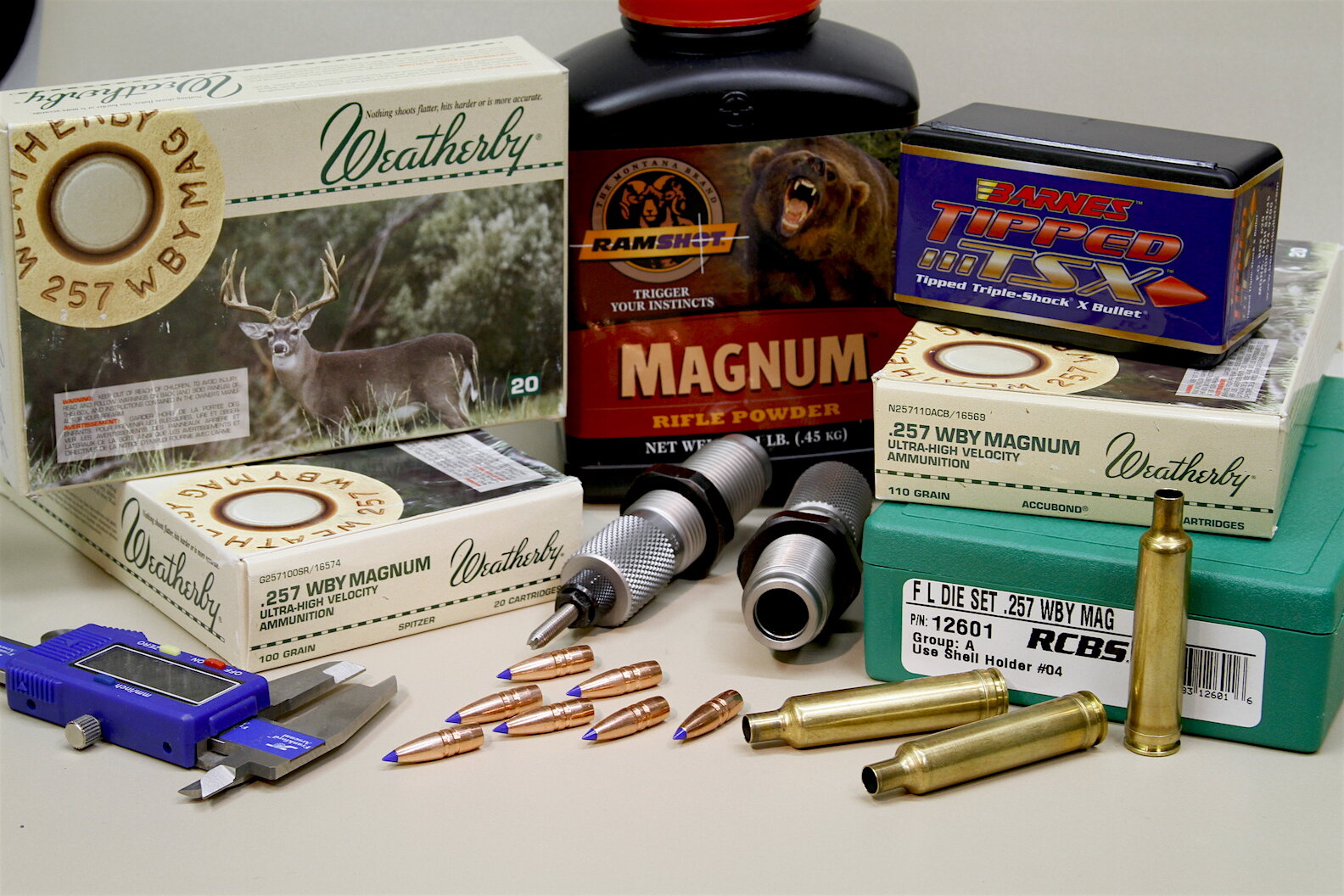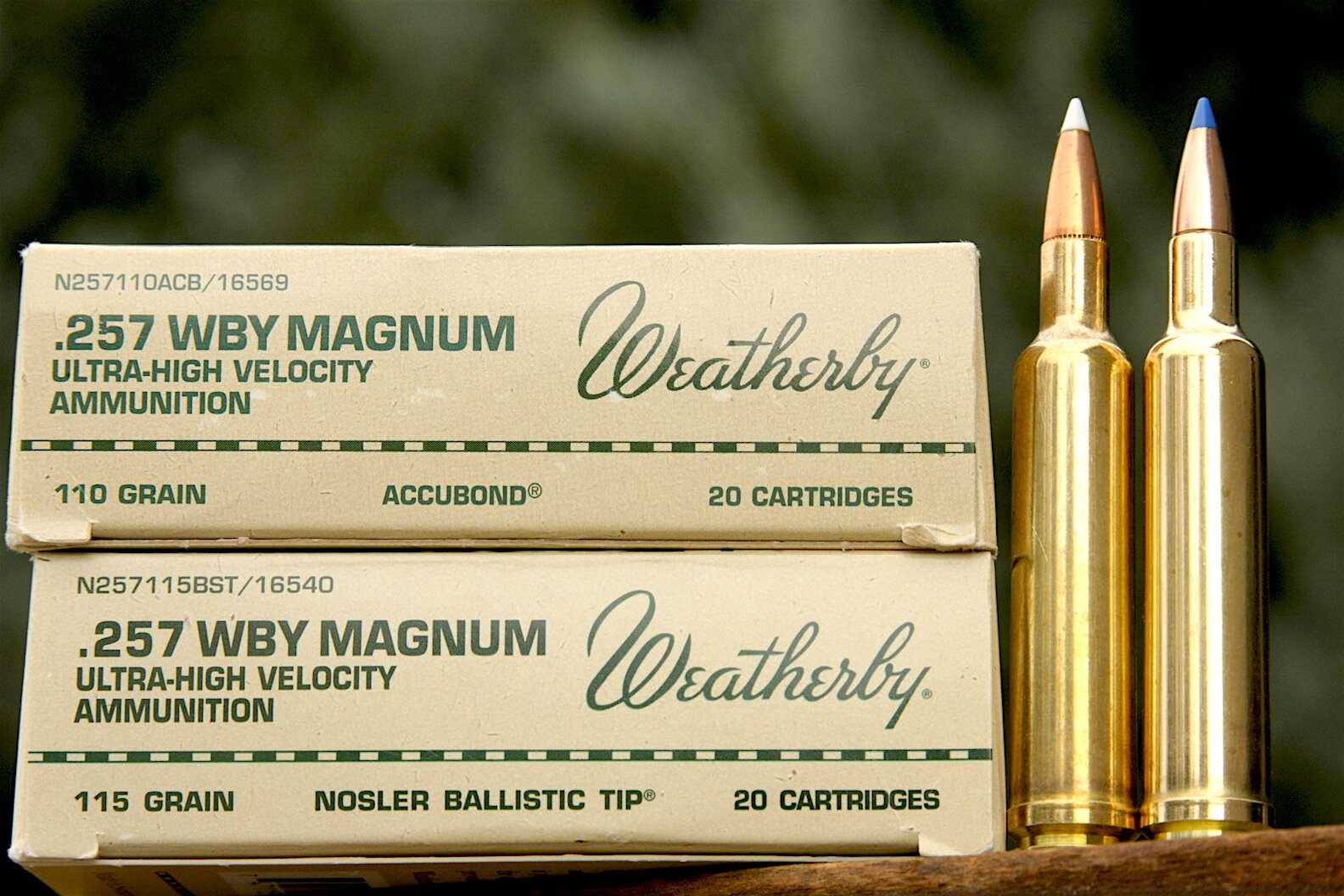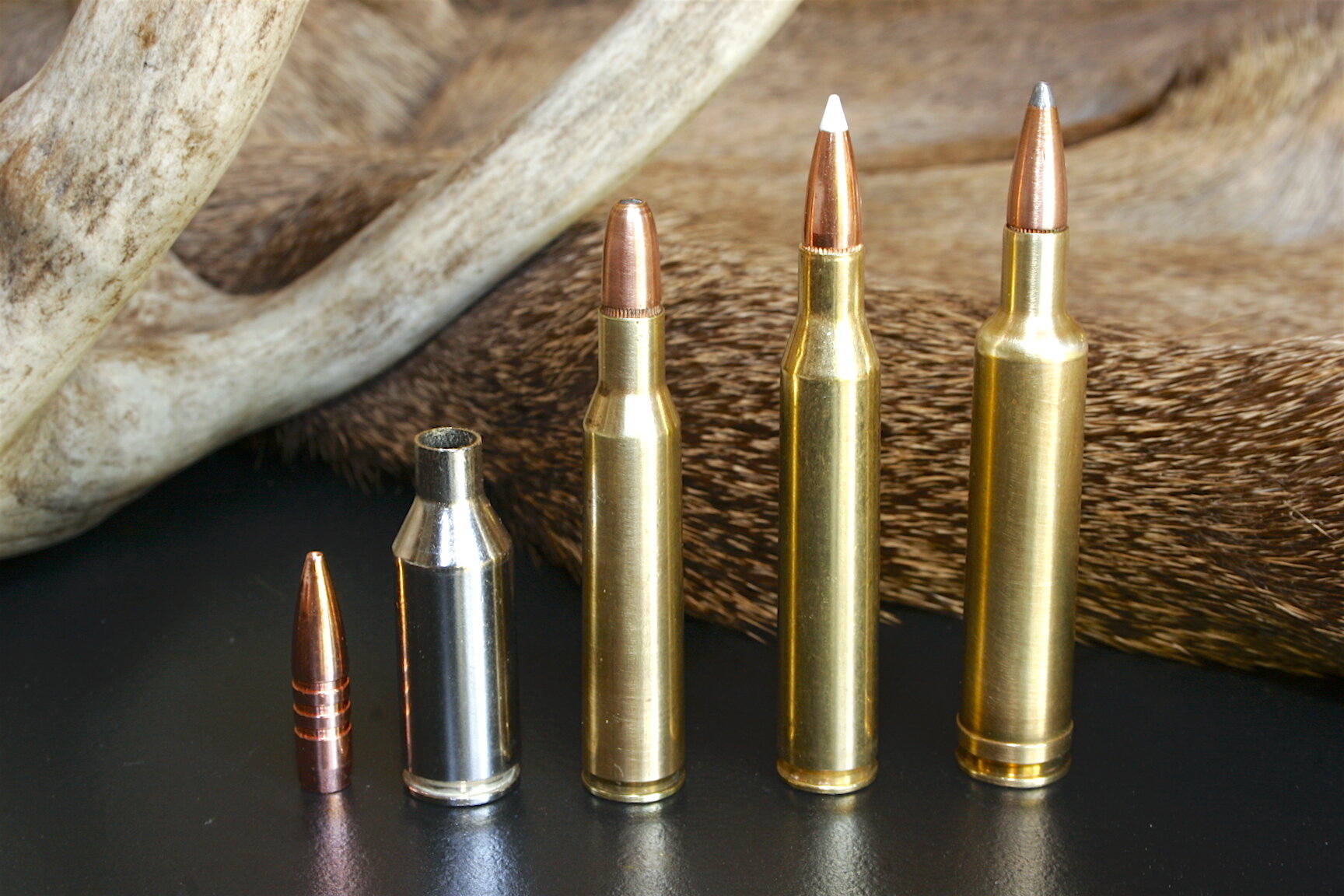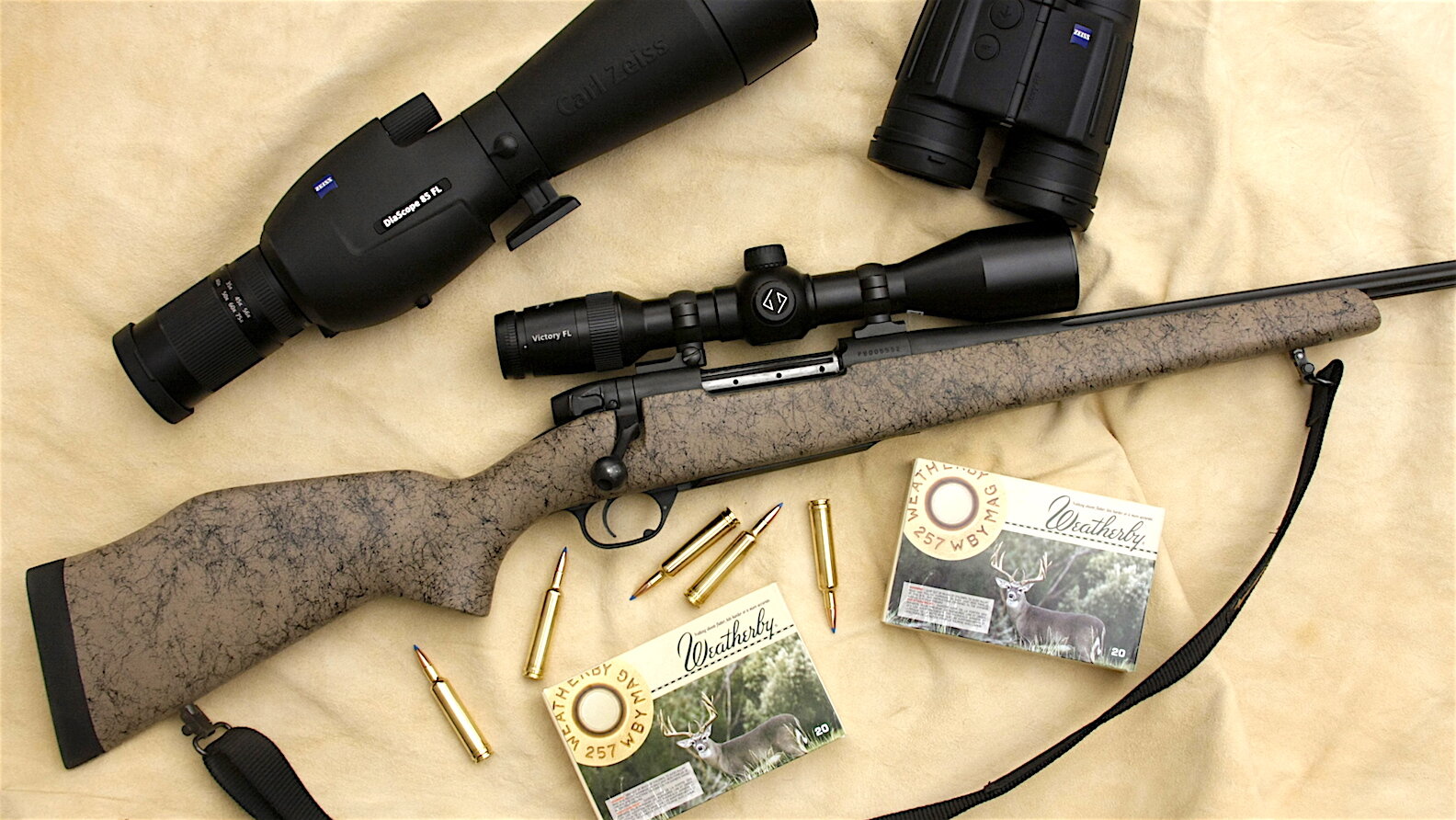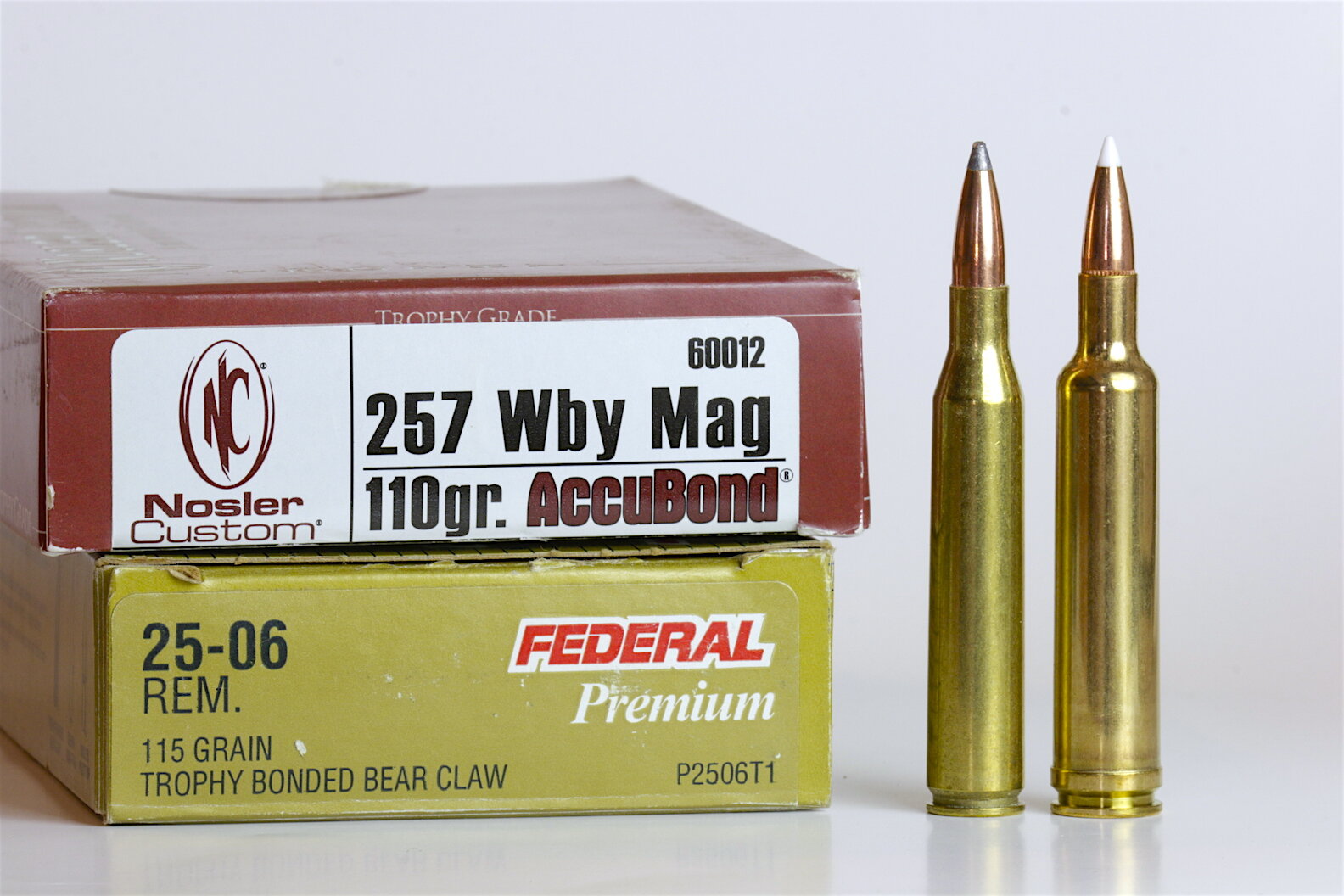Speed Demon 257 Weatherby Magnum
The 257 Weatherby Magnum may be the most overlooked, under-appreciated, mild recoiling, flat-shooting, hard-hitting centerfire rifle cartridges you’ve never fired. Perhaps you should rectify that oversight.
Photo shows two boxes of 257 Weatherby Magnum ammunition with two cartridges.
In a shooting/hunting world obsessed with flat-shooting, wind defying, hyper-accurate, long-range rifles, cartridges that fire .257” diameter bullets have been overlooked. It didn’t used to be that way.
The Surprising History of 25-Calibers and Rise of 257 Weatherby Magnum
Back in the first third of the 20th Century 25-calibers were quite popular. They began in the late 19th century soon after smokeless powder added enough velocity to offset the weight lost to small caliber bullets. There was the 25-20 Single Shot, 25-20 Marlin, 25-20 Winchester (still around!), 25-21 Stevens, 25-25 Stevens, 25-36 Marlin, 25 Remington and 25-35 Winchester (also still kicking.) But things didn’t really start to sizzle until Charles Newton created the 250-3000 Savage for the Savage Model 99 lever-action rifle. This was the first commercial cartridge to hit the 3,000 fps mark. It had to spit an 87-grain bullet to do this. The year was 1915.
Just five years later A.O. Niedner introduced rifles for his 25 Niedner, the 30-06 case necked down to hold a .257” bullet. This finally became the 25-06 Remington in 1969. Talk about testing the market before taking the leap!
25 caliber cartridges include 25 WSSM, 257 Roberts, 25-06, and 257 Weatherby Magnum.
Prior to the commercial ascendancy of the 25-06 Remington, however, there was the 257 Roberts. Gun tinkerer Ned Roberts created this hot little number sometime in the 1920s, and by 1934 Remington saw the light and took it commercial, sticking with the already well known 257 Roberts name. Until the 243 Winchester and 244 Remington appeared in 1955, the 257 Roberts was the dual purpose varmint/deer cartridge of choice across the land.
Clearly, American shooters in the first half of the 20th century were creating a cult of the “quarter bore,” finding it a more-than-sufficient caliber for most North American game — black bears, elk, and moose included. Still, it surprises many to learn that Roy Weatherby contributed to the excitement clear back in 1945. Yes sir. That’s when he shocked the shooting world with his belted 257 Weatherby Magnum.
To put this in perspective, 1945 was the year WWII ended. Hunters were thinking the 257 Roberts was pretty hot stuff, pushing a 100-grain deer bullet 2,900 fps, maybe 3,000 fps at best. Suddenly this Weatherby pops up, belting the same bullet an additional 600 fps. A 100-grain bullet moving 3,600 fps? Oh yeah.
How Roy Weatherby Got 3,600 fps From His 257 Weatherby Magnum
To reach this speed, Weatherby first made a high volume case by modifying the then popular, belted 300 H&H Magnum. He reduced case length from 2.850” to 2.549”, straightened the side walls, and added his double radius shoulder which was perhaps more showmanship than substance. Regardless, the belted brass case held 84-grains of water and was stuffed with roughly 64 grains of powder. That did the trick. A post-war American shooting public hot for everything fast and powerful (the rocket, jet plane, and atomic bomb had just been invented) lusted for the 257 Weatherby Magnum.
But wait a minute. If it was so fast and alluring, why didn’t it become more popular? Because Weatherby kept if proprietary. You could only buy it in a Weatherby rifle, not a Winchester, Remington, or Savage. Blue-collar Americans lusted after a 257 Weatherby the way they lusted after a Cadillac but drove a Ford.
Image shows a 257 Weatherby Magnum Mark V rifle.
Today you can find other rifles chambered for the 257 Weatherby, yet the cartridge still remains less than wildly popular, probably because factory ammunition is limited and rather expensive. Weatherby sells it, of course, and so does Hornady, Nosler, Choice Ammunition, Double Tap, and HSM. Snoop around and you might find more. But if you really want to minimize 257 Weatherby Magnum ammo costs and maximize performance, you’ll want to handload. Price then is about the same as handloading a 30-06.
Modern Powders, Bullets, Pressures, and Twist Rates for the 257 Weatherby Magnum
With today’s slow burning powders in rifles with 26” barrels, handloaders can safely hit 3,576 fps (Nosler Reloading Guide 8) with 100-grain bullets, 3,480 fps with 115-grainers, and 3,400 fps with 120-grain projectiles. Compare that to the top end 6.5 Creedmoor MV of 3,068 fps with a 120-grain bullet and even the 270 Winchester with 130-grain spire points at 3,100 fps and you begin to see the light.
But there’s a catch and it’s abbreviated B.C. Most .257” bullets top out at 120-grains, and at that weight even the really sleek, long boat-tail versions have a hard time breaking .450 B.C. Many 140-grain 6.5mm bullets (.264”) are exceeding .600 B.C. Why not make longer, sleeker, higher B.C. .257” bullets? Because most old, 25-caliber rifles have twist rates of 1-14”, 1-12”, or 1-10” at best. Even Weatherby rifles are saddled with a 1-10” twist in 257 Weatherby Magnum. To fix this you’d have to mount an aftermarket, 1-9" or 1-8" or even 1-7.5" twist barrel on your rifle. (There are some small bullet makers like Blackjack offering high B.C. 130-grain and 131-grain .257 bullets).
To maximize B.C. in .257, most bullet makers stick with the best form factors they can put in 115- to 117-grain bullets. The results are bullets as long as a 1-10” twist barrel can stabilize. This isn’t all bad, however, because the lighter bullets shoot faster and thus flatter than the 120s.
The highest B.C. .257 bullet I could dig up for 1-10" twist barrels is the 115-grain Berger VLD Hunting with a claimed G-1 B.C. of .483. We’ll compare it to Hornady’s .264” ELD-X rated .625 B.C. at 6.5 Creedmoor velocities. (G-7 B.C. numbers are a more accurate predictor of performance with the extremely sleek, long, boat-tail bullets, but most shooters are more familiar with G1 B.C. numbers. We'll stick with those so we don't confuse readers.)
257 Weatherby Magnum Versus the 6.5 Creedmoor
We’ll zero both for maximum point blank range with an 8-inch target diameter. This means we’ll zero so no bullet crests higher than 4 inches above point-of-aim. When it drops 4 inches below point of aim, it has reached maximum point blank range for a pronghorn-sized target. Velocities are taken from reloading manuals. Individual handloaders may claim higher MVs than these, but I can’t and won’t sanctify what could be dangerously high pressures in some readers’ personal handloads. We’re sticking with published data.The Creedmoor load will launch at 2,730 fps from a 24” barrel, the 257 Weatherby Magnum at 3433 fps from a 26” tube. Fired at sea level, 10 mph right angle wind.
Ballistic Table
As we can see, the 257 Weatherby Magnum shoots much flatter than the Creedmoor. Surprisingly, it hangs right with it in wind deflection. As for energy, the 6.5 Creedmoor carries 1,000 f-p to just beyond 700 yards. The 257 Wby. Mag. carries it past 750 yards. Clearly the 257 is the ballistically superior round to 800-yards. You pay the price, however, in ammo costs and recoil. In an 8-pound rifle, the 257 Wby. Mag. should hit your shoulder with about 21.7 f-p force at 13.2 fps velocity, about like a 270 Winchester. The Creedmoor hits 14.8 f-p at 11 fps velocity in the same 8-pound rifle. For comparison, the 30-06 pushing a 165-grain bullet 3,000 fps generates 26 f-p at 14.5 fps. Compared to the 25-06 Remington, the 257 Weatherby Magnum pumps out roughly 600 f-p more energy at the muzzle and 150 to 200 fps more velocity.
One of the reasons the 257 Wby. Mag. goes so fast is its allowed pressure, 65,000 psi. The 25-06 is limited to 63,000 psi, the 6.5 Creedmoor 62,000 psi.
Image shows 257 Weatherby magnum and 25-06 Remington ammo.
257 Weatherby Magnum on Game
I haven’t used the 257 Wby. Mag. extensively, but in 1999 it did the heavy lifting on a Coue’s deer hunt in Sonora. I was shooting a light, sleek, custom M700 from Rifles, Inc. that pretty much put all bullets right where the scope reticle looked, sub-MOA. This was the year the first Leica laser range finder came out. Mine said 351 yards. I held dead on and that’s just what the buck became. Dead on the ground. A wide non-typical with palmated main beams, it green scored 121 Non Typical B&C. I liked that rifle so much that I used it to cull a half dozen whitetails and at least that many coyotes. I can’t remember it ever missing, but if it did, it wasn’t the rifle’s fault.
About eight years ago a Merkel single-shot in 257 Wby. Mag. sent a 100-grain Barnes TTSX through a 3-inch alder limb and then through both shoulders of a black bear during a hunt with Vancouver Island Guide Outfitters. In Wyoming a genuine Weatherby Mark V rifle in 257 Wby. Mag. made short work of a fine pronghorn buck. I rather regret that I haven't had occasion to use one on elk or moose. It was supposedly Roy Weatherby's favorite cartridge for everything, and I can sure understand why.
Image shows hunter with black bear and 257 Weatherby Magnum rifle.
If you’re looking for a mild-recoiling, flat-shooting, hard-hitting centerfire rifle you’ve probably overlooked in the past, look to the 257 Weatherby Magnum. I'm betting you won't be disappointed.
The author tests and shoots a wide variety of cartridges and calibers only because he's dedicated to providing information to his readers.


